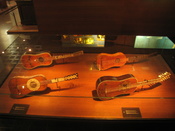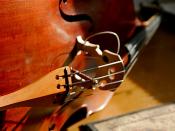The History of the Stringed Instrument to 1800
Stringed instruments of one type or another are employed in musical activities worldwide. Despite some differences, they share many similarities in their mode of construction and manner of performance. The stringed instrument has a structural and playing adaptability that lends itself well to the rendition of the music of diverse cultures.
The way a stringed instrument works is a tightened material (silk gut, metal or nylon) when plucked or bowed oscillates or vibrates at a certain frequency (cycles per second). The instrument vibrates along with the string and amplifies the sound waves.
The harp is a stringed instrument in which the strings are plucked with the fingers. In different forms it was played by people of nearly all lands throughout the ages.
The oldest stringed instrument that I could find is the Egyptian bow harp, taken from Egyptian mural drawings. It dates back to 3000 B.C.
and is with some probability the ancestor of modern harps.
Another is a Cycladic marble statue of a harpist from the island of Keros. It was found together with Phoenician idols which points to the possibility that this harp originated in Phoenicia, which is mentioned in Greek literature as one of the countries that in ancient times used triangular stringed instruments. It also dates back to 3000 B.C.
The Kithara originated in ancient Greece, dating back to 490 B.C. The Kithara was a wooden string instrument that was played with a plectrum, which is similar to what we know today as a pick, and was usually made from the horns of animals and shaped into a device that looked similar to a spoon. The early form of the kithara had a rounded base, while the later form had a flat base. The strings of the instrument...


great essay
great essay very detailed and over many instruments. great job
0 out of 0 people found this comment useful.